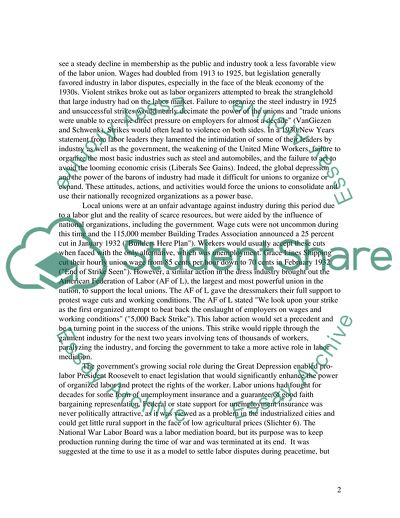
- Home
- Free Samples
- Premium Essays
- Editing Services
- Extra Tools
- Essay Writing Help
- About Us
- Studentshare
- Subjects
- Miscellaneous
- Union 1830-1835
Union 1830-1835 - Essay Example

- Subject: Miscellaneous
- Type: Essay
- Level: Masters
- Pages: 4 (1000 words)
- Downloads: 0
- Author: denesikjennyfer
Extract of sample "Union 1830-1835"
In addition, the depressed economic environment made it possible for the politics of socialism to creep into the American consciousness. Indeed, the period of 1930-1935 would see stagnation in union membership as a percentage of the labor force (VanGiezen and Schwenk). However, the politics of the New Deal and the alliances that were formed would lay the foundation for the greatest union expansion, in both size and power, in US history beginning in 1935. The Industrial Revolution prompted the formation of unions as it had revolutionized the concept of work, altered the social life of the worker, and placed the worker at risk in the new workplace.
Workforces were concentrated in large factory settings, which created shared social experiences that facilitated the organization of the unions. The division of labor and the depersonalization of industry changed the concept of labor from the craftsman to the idea of a member of a trade that could be marketed and sold as a commodity. Mechanization and science had exposed the workers to greater health risks and more dangerous workplaces. Child labor and the attitude towards women in the workplace were a central focus of labor rights.
Unions gave the workers collective bargaining power and were formed as a means to protect the worker from being exploited economically and assure that the workplace would be as safe as reasonable. In April 1903, poor working conditions prompted labor leader Frank Buchanan to call for a national "open war against the rapidly growing concentrations of capital" (qtd. in "Predicts General Labor War"). A few states approached the problem with laws that limited the number of hours that a child could be worked, barred them from dangerous occupations, and provided for health inspectors to monitor the employment practices regarding minors (Guild 8-11).
However, the unions sought to protect all workers, including men,
...Download file to see next pages Read MoreCHECK THESE SAMPLES OF Union 1830-1835
Analysis of Panic of 1837
The Caudillo of the Andes: Andres de Santa Cruz
American President: Abraham Lincoln
The American Revolution - Discussion Question Only
Dred Scott
Urbanisation in 19th Century Britain
Poor Law Amendment Act of 1834
Abraham Lincoln

- TERMS & CONDITIONS
- PRIVACY POLICY
- COOKIES POLICY